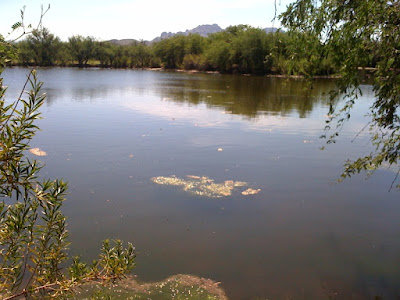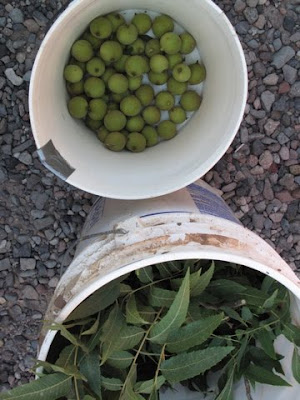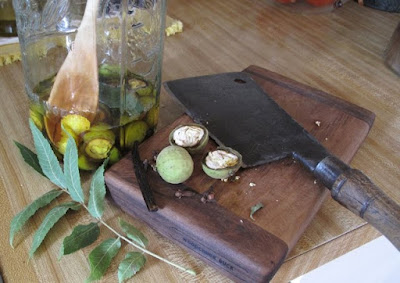



 Walnuts (Juglans major) in the southwestern states are beginning to ripen . . . time to try something I've had in my nature notes for some time: vin noix (green walnut wine), made from noix de Saint-Jean (Saint John's walnut). One of the best tutorials on the origin and making of this European aperitif is on William Rubel's website (williamrubel.com). Traditionally in France the walnuts (from J. regia) are harvested around June 24, which is Saint Jean's Day, the feast of Saint John. Our southwestern species don't begin to grow until later in July. I don't know if our wild walnuts will yield a quality flavored product (it's actually one of several flavorings in what's known as a fortified wine, since it's made by infusing alcohol and wine with botanicals and spices). The recipes refer to the astringent quality of the walnuts, and ours certainly have that characteristic. I gathered these in New Mexico's Mimbres Valley, northeast of Silver City.
Walnuts (Juglans major) in the southwestern states are beginning to ripen . . . time to try something I've had in my nature notes for some time: vin noix (green walnut wine), made from noix de Saint-Jean (Saint John's walnut). One of the best tutorials on the origin and making of this European aperitif is on William Rubel's website (williamrubel.com). Traditionally in France the walnuts (from J. regia) are harvested around June 24, which is Saint Jean's Day, the feast of Saint John. Our southwestern species don't begin to grow until later in July. I don't know if our wild walnuts will yield a quality flavored product (it's actually one of several flavorings in what's known as a fortified wine, since it's made by infusing alcohol and wine with botanicals and spices). The recipes refer to the astringent quality of the walnuts, and ours certainly have that characteristic. I gathered these in New Mexico's Mimbres Valley, northeast of Silver City.
Vin de Noix (from William Rubel)
40 young walnuts that can be pierced with a needle, rinsed and quartered
1 liter alcohol such as brandy, marc, eau de vie, or vodka
5 liters red wine
1 kg sugar (2 pounds)
One or more of the following are often added, but are optional
12 walnut leaves
Zest of 1 orange
4 to 8 cloves
1 vanilla bean
[I reduced the recipe to 15 wild walnuts; 1.25 L red Italian table wine; .25 L vodka; 225 g sugar; 4 walnut leaves; half a vanilla bean; zest of 1/4 orange; 4 cloves.]
1. Pick the walnuts in late June when the walnuts are well formed, but can still be pierced with a needle. Place all of the ingredients in an 8 quart (8 liter) non-reactive container with a lid. I use a large glass jar. Store in a cool dark place for 6 to 8 weeks, shaking occasionally.
2. Strain through cheesecloth into a bowl. Taste, and adjust the sugar if you want the drink to be sweeter. Bottle and store in a cool dark place until the cold weather.
 Check back in eight weeks for a taste test. I'll also look for ripe walnuts in the fall; these make excellent pigment.
Check back in eight weeks for a taste test. I'll also look for ripe walnuts in the fall; these make excellent pigment.
